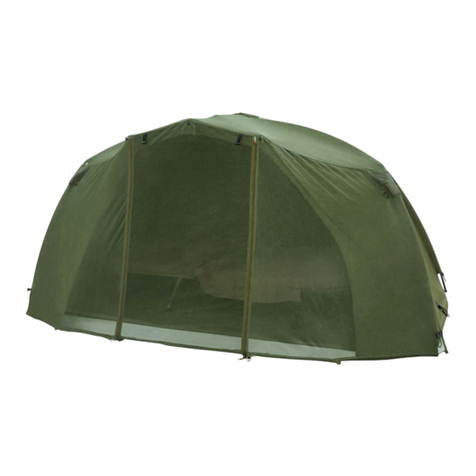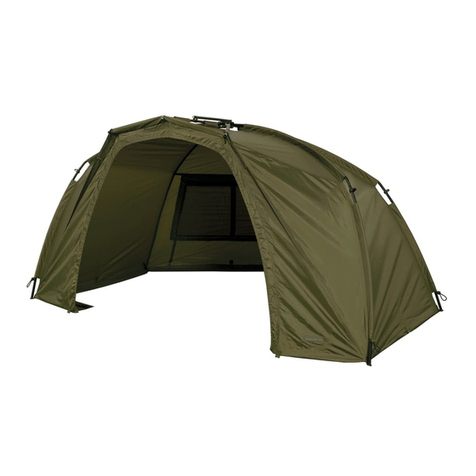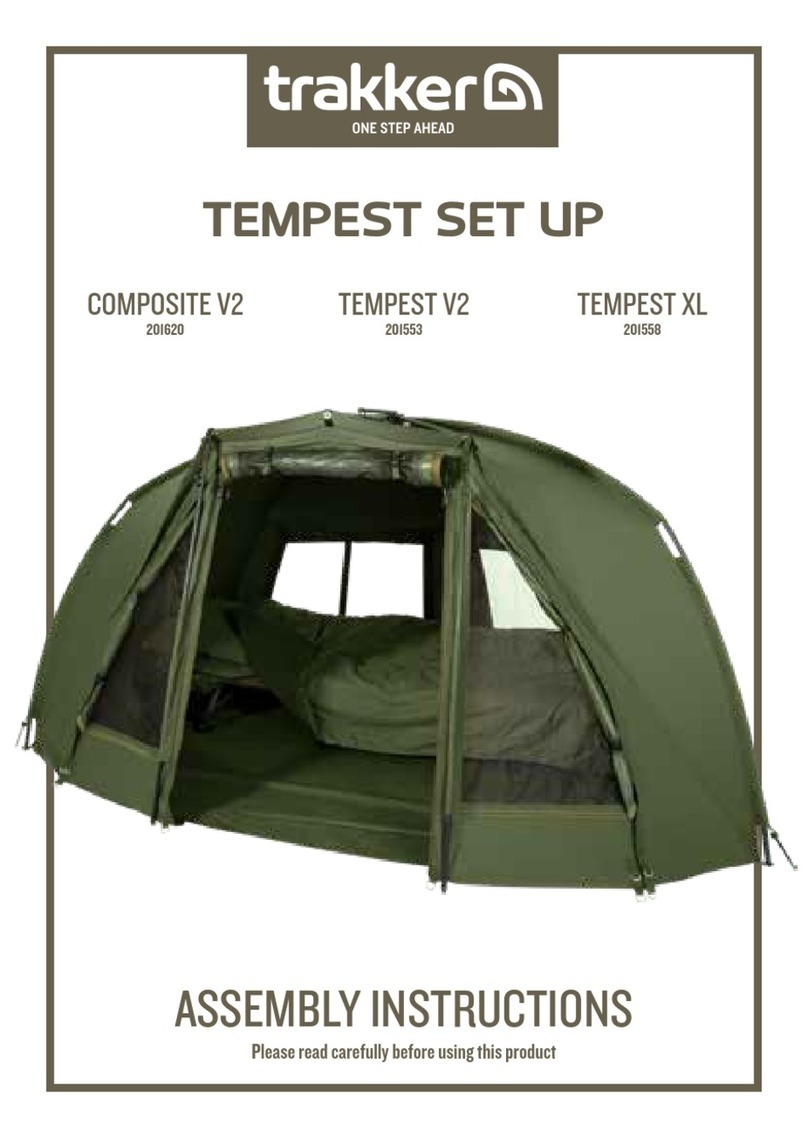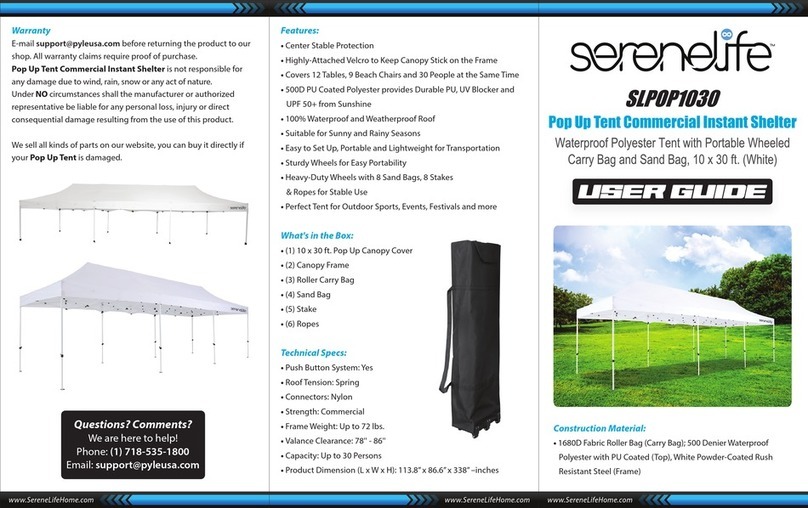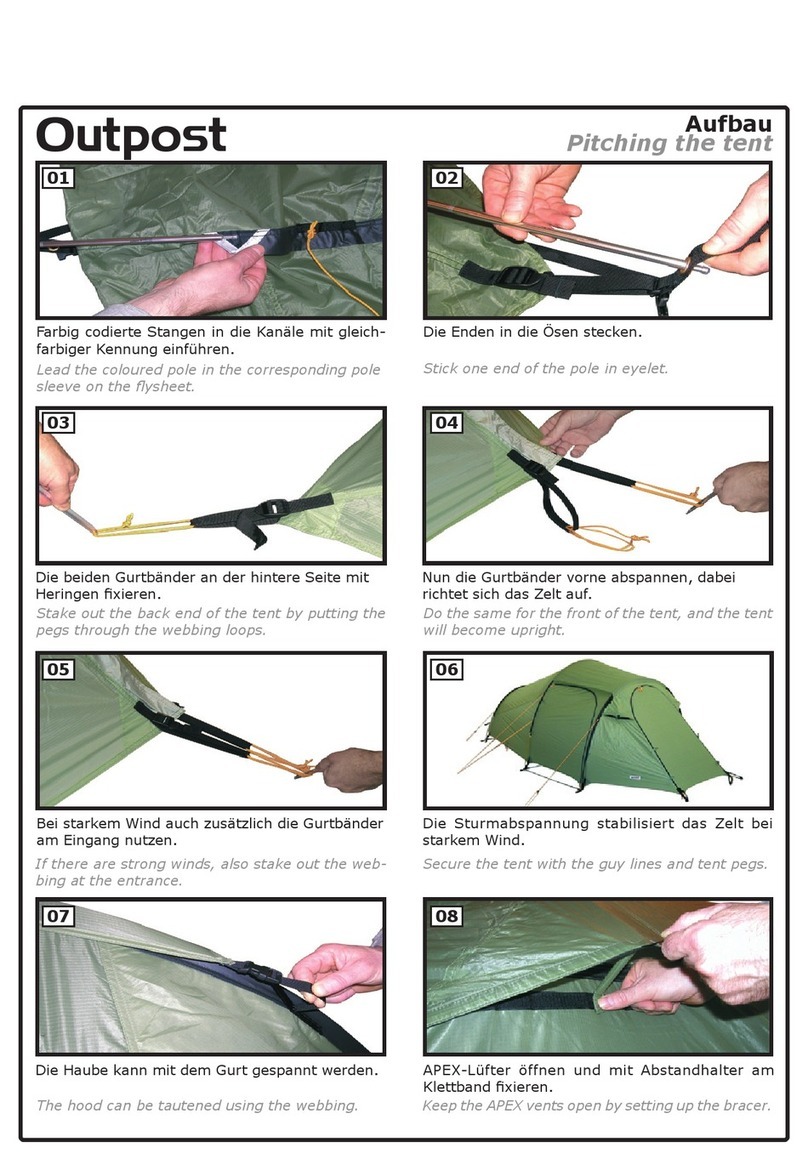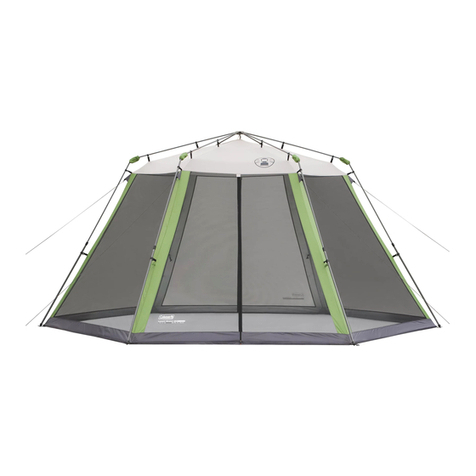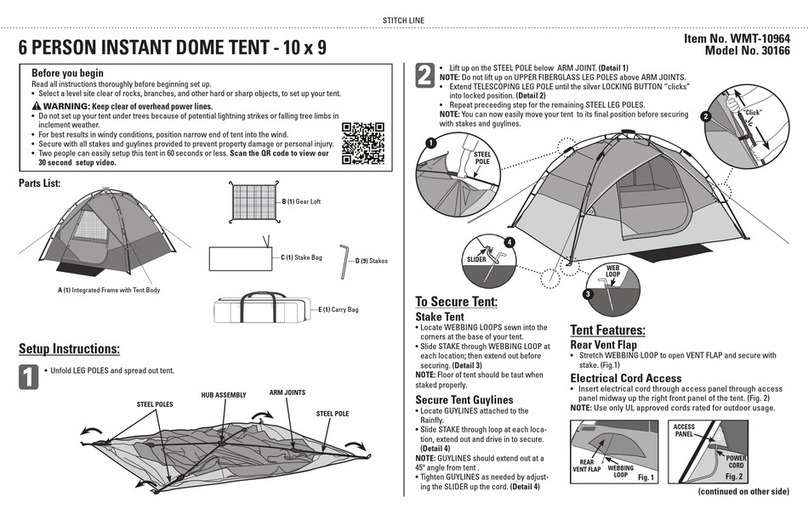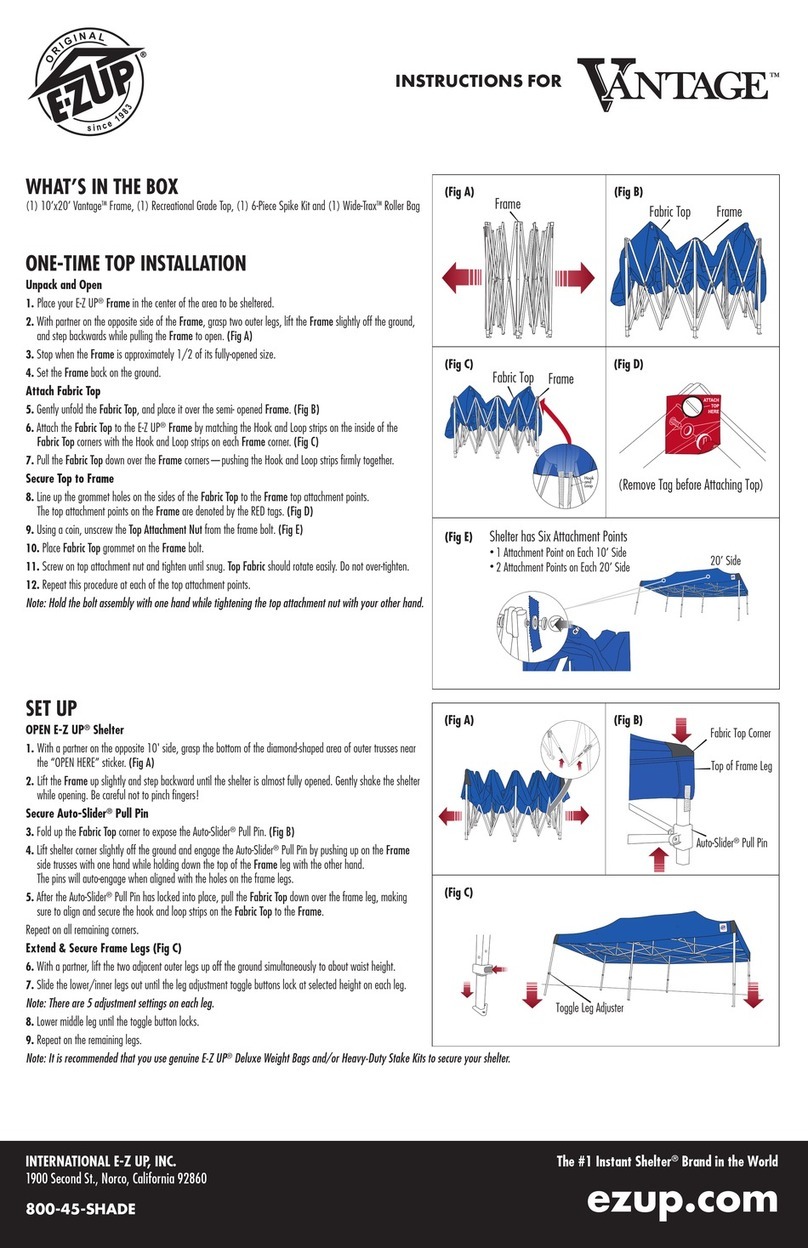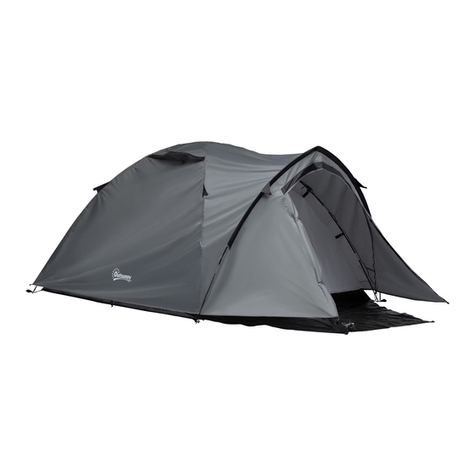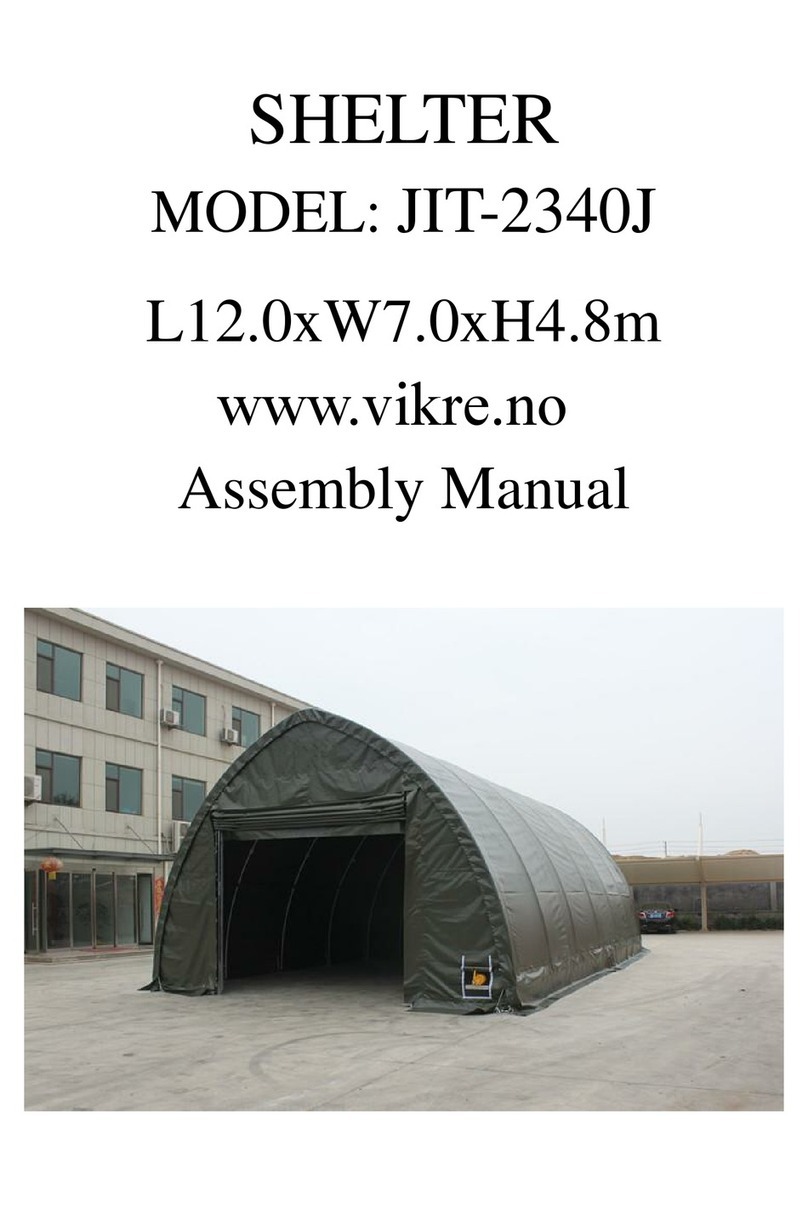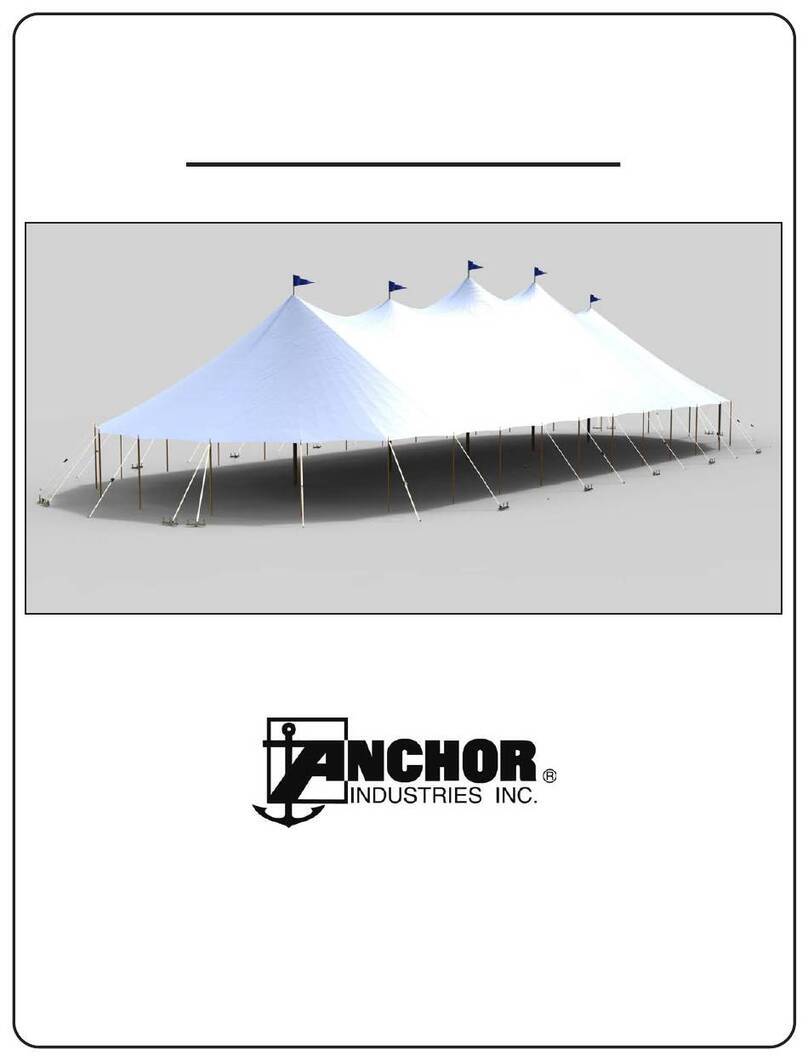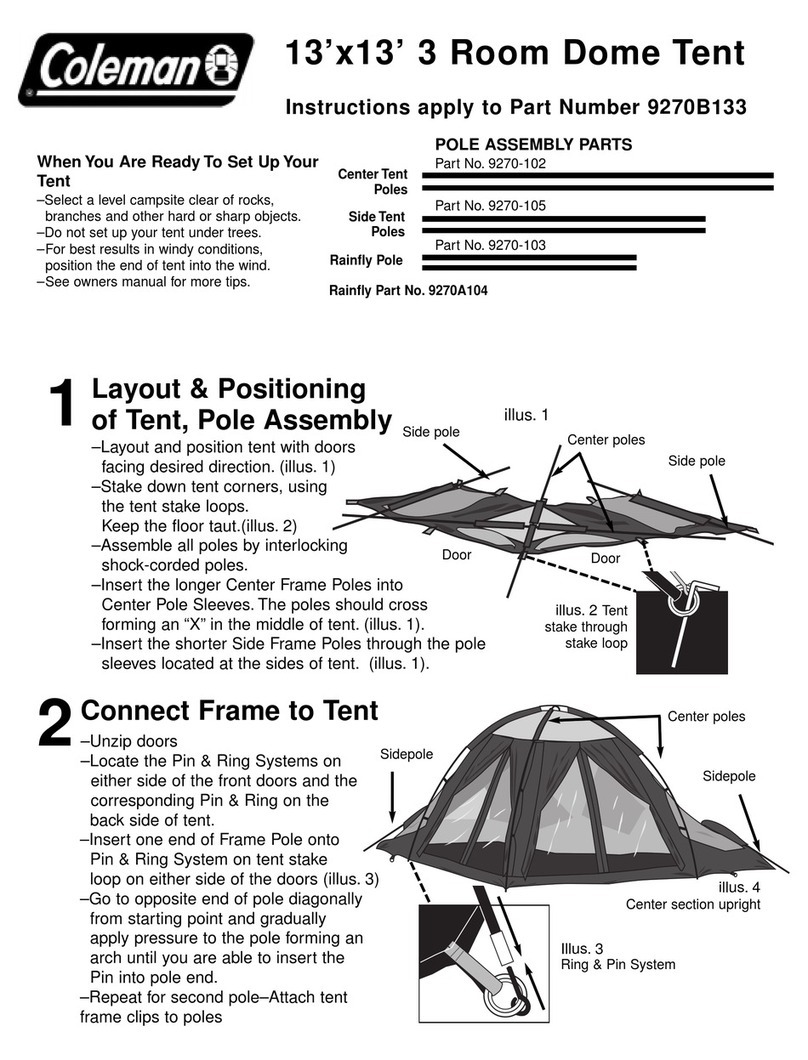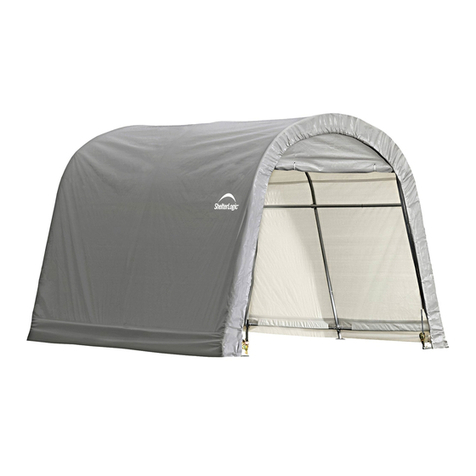Trakker SLXv3 User manual

Please read carefully before using this product
SLXv3
ASSEMBLY INSTRUCTIONS
BIVVY ONE-MAN
201205 BIVVY TWO-MAN
201405

ASSEMBLY
SLXv3
1. To disassemble the SLX V3, firstly remove the wrap
if it is in place and then unpeg each of the pegging
points and collapse the frame. Release the tension by
disconnecting the frame from the groundsheet and
pull the porch pole from its two lugs.
2. Starting from the centre, unplug the frame sections
and twist them approximately 90 degrees to prevent
them plugging back together. It may help if you shake
the pole slightly as you unplug the frame sections,
as this will help release the spigot. Fold the arms into
the middle as you go, making sure there is no material
wrapped around the ends of the frame sections
because this could damage the cover. There is no
need to remove the porch pole completely during this
process; the bivvy will fold away neatly with it in place.
DISASSEMBLY
1. Lay out the groundsheet where you want to erect your
SLX V3 Bivvy, with the elasticated pegging points on
the underside. The doorway is indicated by a small
Trakker label. If it is windy, it is advisable to use a
couple of pegs to hold the groundsheet in place.
2. Place the SLX V3 in the centre of the groundsheet,
kneel down and open out the bivvy poles, plugging
together the frame sections as you go. Ensure all the
spigots are fully inserted. You should also assemble
the porch pole during this process and locate it onto
the porch knuckles.
3. The assembled frame should be wider than the
groundsheet. Attach the two rings on the inside edges
of the base plates to the hooks on the groundsheet.
This tensions the frame and takes up the play in
the spigots. If the bivvy is to be used without the
groundsheet, you can use the tension strap supplied
to tension the frame. It is important you do not over-
tension the frame.
4. Peg out the rings at the rear of the bivvy, using the
groundsheet as a rough guide. Please note: The
groundsheet is slightly oversized to allow for uneven
ground, so do not stretch it out too tight. The pegs
should also go through the elasticated rings on the
groundsheet, which will hold it in place. The SLX V3
comes supplied with hardened steel pegs, which are
adequate for good ground conditions, but specialist
pegs may be required for gravel, sand, etc.
5. Now insert two pegs through the rings at either side of
the door and pull the SLX V3 forward, pegging down
again, using the groundsheet as a rough guide. It helps
if the door is in a closed position while you do this.
On even ground the door should peg out on the middle
ring; do not over-tension and then peg out the rest
of the pegging points. Create extra tension by looping
the elastics above the pegging points over the plastic
T pegs.
6. Ensure the groundsheet is positioned over the draught
skirts around the inside of the bivvy. The door is fitted
with two-way zips, so it may be opened from the top
or bottom. The door is longer than the bivvy so it
can act as a draught skirt and be tucked under the
groundsheet.
7. The frame support system (supplied) should now be
installed. The frame support system clips onto the
poles in the centre and pushes the frame forward. This
supports the SLX V3 Bivvy frame without the need to
peg out the front, however, this will compromise its
stability and should only be done when the weather
conditions allow.
BIVVY ONE-MAN
201207 BIVVY TWO-MAN
201407

SLXv3
FITTING THE INNER CAPSULE
FITTING THE OPTIONAL WRAP
1. Unfold the capsule and place inside the bivvy on top
of the groundsheet with the front door to the front of
the bivvy.
2. Using the red toggles to locate the capsule centrally,
start at the back of the shelter attaching the toggles in
the corresponding loops. The rear vent in the capsule
should be in line with the rear vent on the bivvy.
3. Work your way from back of the bivvy to the front
clipping the toggles to the corresponding loops
situated inside the bivvy.
4. Finish this process at the front of the bivvy by pegging
the front pegging points on the capsule through the
bivvy and groundsheet pegging points.
1. Erect the SLX V3 Bivvy in the correct way, take the
wrap from its carrybag and carefully unfold it.
2. Cover the SLX V3 with the wrap,starting by pulling
the back of the wrap over the front of the bivvy. If
it is windy, it may help to pull the wrap towards the
prevailing wind.
3. Peg out the two rear pegs by pushing the peg into the
ground approximately 10cm from the bivvy and looping
the elastic over the plastic T and then come to the
front and peg the front two pegs either side of the
door into position. It helps if the door is in a closed
position while you peg out these points. On even
ground the door should peg out on the middle ring;
do not over-tension.
4. Now peg out the rest of the winter wrap. If the wrap
does not look fully tensioned, you can readjust any
of the peg points. Please note: Condensation will still
form in the single skin porch area.
BIVVY ONE-MAN WRAP
201207 BIVVY TWO-MAN WRAP
201407

SLXv3
WARRANTY INFORMATION
For more information on products
and a full list of retailers, checkout
www.trakkerproducts.com
Trakker Products Ltd Unit C5,
Nunnery Drive Parkway Industrial Estate
Sheffield, S2 1TA
Tel: +44 (0)1142 727 783
Fax: +44 (0)1142 725 904
Email: [email protected]
STORAGE
Storage is one of the most important aspects of bivvy care.
Your bivvy should be packed away dry. If packed away wet,
it should be dried within 24-hours of returning from your
session. If the bivvy is left wet, mildew will form, which can
severely damage the material and tape seals. It is worth
checking your bivvy frequently for signs of wear and tear,
which may require attention.
Remember: Store your bivvy in a cool dry place away from
sources of heat. The carry bag should be left unzipped if
stored for extended periods. Reproof with Fabsil Gold at
least once annually. Cleaning and reproofing your bivvy
will strengthen the fabric and improve its ability to repel
water.
CLEANING
– Do not use detergents to clean as they may harm the
proofing.
– Never machine wash or tumble dry.
– Avoid contact with abrasive scrubbing agents/cloths.
– Avoid contact with fuel, oil and chemicals.
Your warranty does not cover contact with the
aforementioned agents/chemicals.
WARRANTY
All Trakker shelters and wraps are covered by a 12-Month
Manufacturer Warranty supplied as standard. The
warranty runs from the date of purchase and covers
replacement at our expense and discretion (with the
same or similar model from our current range) or repair
including parts and labour in the event of a manufacturing
fault appearing with your shelter. Your warranty cover
excludes faults arising from misuse, incorrect or negligent
repairs or “Acts of God”. Fabric damaged caused by
mildew, incorrect washing or improper storage is not
covered by the Trakker warranty.
This guarantee is only valid when used for recreational
purposes, not including commercial usage i.e. hiring, use
by outdoor centres etc. Please ensure that all products are
clean and dry prior to being returned.
No consequential loss may be claimed
under this guarantee.
Your warranty is provided in addition to
any statutory rights.
BIVVY ONE-MAN WRAP
201207 BIVVY TWO-MAN WRAP
201407
BIVVY ONE-MAN
201207 BIVVY TWO-MAN
201407

MONTAGE
SLXv3
1. Pour démonter le SLXv3, premièrement enlevez la
couverture si c’est en place et puis détachez tous les
points de rattachement et pliez le châssis. Relâchez la
tension en séparant le châssis du tapis de sol et tirez
le mât de l’avancée de ses deux tasseaux.
2. Commençant au centre, détachez les sections du
châssis et tordez-les d’environ 90 degrés afin de les
empêcher de rejoindre. Il serait prudent de secouer
légèrement le mât pendant que vous détachez les
sections du châssis, car cela aidera à relâcher les
faussets. Pliez les mâts vers le centre en assurant
qu’il n’y a pas de la toile enroulée autour des bouts
du châssis car cela pourrait endommager le wrap. Il
ne faut pas enlever le mât de l’avancée complètement
pendant ce processus ; le bivvy se pliera adroitement
avec le mât en place.
DÉMONTAGE
1. Mettez le tapis de sol ou vous voulez ériger votre
SLXv3 Bivvy, avec les points de rattachement
élastiqués sur le dessous. La porte est indiquée par
une petite étiquette Trakker. Si c’est venteux, il serait
prudent d’utiliser quelques sardines pour tenir en
place le tapis de sol.
2. Mettez le SLXv3 au centre du tapis de sol, agenouillez-
vous et déployez les mâts du bivvy, et unissez les
sections du châssis. Assurez-vous que les faussets
sont insérés entièrement. Vous devriez assembler le
mât de l’avancée pendant ce processus et le placer
dans les tasseaux.
3. Le châssis assemblé devrait être plus étendu que le tapis
de sol. Attachez les deux bagues sur les bords intérieurs
des plaques de base avec les crochets sur le tapis de sol.
Cela met le châssis sous tension et raidit les faussets. Si
vous utilisez le bivvy sans un tapis de sol, vous pouvez
utiliser la sangle de tension qui est fournie pour mettre le
cadre sous tension. Il est important de ne pas mettre le
châssis sous trop de tension.
4. Fixez les bagues à l’arrière du bivvy, en utilisant le tapis
comme un guide approximatif. Veuillez noter que le tapis
de sol est un peu plus grand que le bivvy pour tenir
compte du sol inégal, donc ne l’étendez pas trop. Aussi,
les sardines devraient passer par les bagues élastiquées
du tapis de sol, qui le tiendra en place. Le SLXv3 est fourni
avec des sardines en acier trempé, qui sont suffisants
pour des bonnes conditions de sol, mais il faut utiliser des
sardines spécialisées pour le gravier, le sable, etc.
5. Maintenant, insérez deux sardines dans les bagues à
chaque côté de la porte et tirez SLXv3 vers l’avant et
fixez par terre en utilisant le tapis de sol comme un guide
approximatif. C’est plus facile si la porte est fermée
pendant ce processus. Sur le sol égal la porte doit être
fixé sur la bague centrale ; ne le mettez pas sous trop
de tension. Ne mettez pas les points de rattachement
sous trop de tension. Vous pouvez créer plus de tension
en bouclant autour des sardines les élastiques qui sont
au-dessus des points de rattachement.
6. Assurez-vous que le tapis de sol est positionné sur
les bandes de toile contre les courants d’air autour
de l’intérieur du bivvy. La porte est équipée des
fermetures éclairs à double sens, donc on peut l’ouvrir
du haut ou du bas. La porte est plus longue que le
bivvy afin d’agir comme une bande de toile contre les
courants d’air et peut être border sous le tapis de sol.
7. Il faut maintenant installer le système du support
pour le châssis qui est fourni. Le système du support
pour le châssis attache sur les mâts au centre et le
pousse vers l’avant. Ceci renforce le châssis du SLXv3
Bivvy sans avoir besoin de fixer le devant par terre,
pourtant, cela compromettra sa stabilité et il devrait
seulement être fait lorsque les conditions climatiques
le permettent.
BIVVY ONE-MAN
201207 BIVVY TWO-MAN
201407

LE MONTAGE DE LA CAPSULE INTÉRIEURE
LE MONTAGE DU WRAP OPTIONNEL
1. Dépliez la capsule et mettez-la à l’intérieur du bivvy
au-dessus du tapis de sol avec la porte vers l’avant du
bivvy.
2. En utilisant les cabillots rouges pour placer la capsule
au centre, commencez à l’arrière de l’abri en attachant
les cabillots dans les boucles correspondantes. L’évent
arrière dans la capsule devrait être conforme à l’évent
arrière du bivvy.
1. Érigez le bivvy SLXv3 de la manière normale, sortez le
wrap du sac de rangement et dépliez-le avec soin.
2. Mettez le wrap sur le bivvy SLXv3 en tirant l’arrière du
wrap sur le devant du bivvy. Si c’est venteux, il serait
prudent de tirer le wrap vers le vent dominant.
3. Fixez les deux sardines à l’arrière en introduisant le
sardine dans le sol et en bouclant la bande élastique
autour du T plastique et puis fixez en position les deux
sardines à l’avant à chaque côté de la porte à l’avant.
Il vaudrait mieux que la porte soit fermée pendant
que vous fixez ces points de rattachement. Sur un
sol uniforme la porte devrait être fixée sur la bague
centrale ; ne la mettez pas sous trop de tension.
4. Puis, fixez le reste du wrap d’hiver. Si le wrap n’est
pas sous la tension correcte, vous pouvez faire des
ajustements aux points de rattachement. Veuillez noter
que la condensation se forme encore dans l’avancée à
revêtement simple.
SLXv3
3. En travaillant de l’arrière du bivvy à l’avant, attachez
les cabillots aux boucles correspondantes situées à
l’intérieur du bivvy.
4. Complétez le processus à l’avant du bivvy en mettant
les boucles sur la capsule par les boucles du bivvy et
du tapis de sol.
BIVVY ONE-MAN WRAP
201207 BIVVY TWO-MAN WRAP
201407

SLXv3
RANGEMENT
Le rangement est un des aspects le plus important du soin
du bivvy. Avant d’emballer votre bivvy, il devrait être sec.
Si vous emballez un bivvy mouillé, il faut le sécher dans
les vingt-quatre heures. Sinon, la moisissure se forme
qui peut endommager gravement la toile et les rubans
adhésifs. Il faut examiner fréquemment votre bivvy pour
les signes d’usure, qui peuvent avoir besoin d’être réparés.
ATTENTION : Rangez votre bivvy dans un endroit frais et
sec loin des sources de chaleur. Il faut laisser ouvert le sac
de transport au moyen de la fermeture éclair si le bivvy est
stocké pendant des périodes étendues. Réimperméabilisez
avec Fabsil Gold au moins une fois par an. Nettoyer et
réimperméabiliser le bivvy rendra la toile plus forte et plus
capable de repousser l’eau.
NETTOYAGE
– N’utilisez pas les détergents car ils pourraient
endommager l’imperméabilisation.
– Ne jamais laver à la machine ni sécher par culbutage.
– Évitez le contact avec les agents de nettoyage et
chiffons abrasifs.
– Évitez le contact avec les combustibles, l’huile et les
produits chimiques.
Votre garantie ne couvre pas le contact avec les agents et
produits chimiques susmentionnés.
LA GARANTIE
Tous les abris et couvertures Trakker sont couverts par
une garantie du constructeur de douze mois en standard.
La garantie commence dès la date d’achat et couvre le
remplacement du produit à nos frais et à notre discrétion
(avec le même produit ou produit semblable de notre
gamme actuelle) ou réparation y compris les pièces et
main d’œuvre en cas de défaut de fabrication avec votre
abri. Votre garantie exclue les défauts créés par l’usage
impropre, des réparations incorrectes et négligentes ou
cas de « force majeure ». Les dégâts à la toile créés par la
moisissure, le lavage incorrect ou le stockage incorrect ne
sont pas couverts par la garantie Trakker.La garantie est
seulement valable quand le produit est utilisé pour des fins
récréatives pas pour l’utilisation commerciale, par exemple
location, utilisation par des centres de plein air. Veuillez-
vous assurer que tous les produits sont propres et secs
avant d’être retournés. Aucune perte indirecte ne peut être
réclamée en vertu de cette garantie. Votre garantie est
fournie en plus de tous les droits statutaires.
INFORMATIONS DE GARANTIE
Pour plus d’informations sur les produits
et une liste complète des détaillants, visitez:
www.trakkerproducts.com
Trakker Products Ltd Unit C5,
Nunnery Drive Parkway Industrial Estate
Sheffield, S2 1TA
Tel: +44 (0)1142 727 783
Fax: +44 (0)1142 725 904
Email: [email protected]
BIVVY ONE-MAN WRAP
201207 BIVVY TWO-MAN WRAP
201407
BIVVY ONE-MAN
201207 BIVVY TWO-MAN
201407

VERSAMMLUNG
1. Um das SLX V3 zu demontieren, entferne zuerst den
Wrap, wenn er montiert ist und dann entferne die
Heringe und klappe den Rahmen zusammen. Löse die
Spannung, indem du den Rahmen von der Bodenplatte
löst und ziehe die Vordachstange aus seinen beiden
Laschen.
2. Ausgehend von der Mitte die Rahmenabschnitte
abziehen und verdrehen ungefähr 90 Grad, um zu
verhindern, dass sie wieder zusammenstoßen. Es kann
hilfreich sein, wenn du die Stangen leicht schüttelst,
während du die Rahmenabschnitte abziehst, da dies
hilft, den Zapfen zu lösen. Falte die Arme während der
Fahrt in die Mitte und achte darauf, dass kein Material
um die Enden der Rahmenabschnitte gewickelt wird,
da dies das Material beschädigen könnte. Es ist nicht
notwendig, die Vordachstange während dieses Vorgangs
vollständig zu entfernen. das Bivvy wird ordentlich
damit weggeklappt.
DEMONTAGE
1. Legen Sie den Zeltboden an die Stelle, an der Sie Ihr
SLX V3 Bivvy aufbauen möchten, mit den elastischen
Verankerungspunkten an der Unterseite. Die Türöffnung
ist durch ein kleines Trakker-Label gekennzeichnet.
Wenn es windig ist, empfiehlt es sich, ein paar Heringe
zu verwenden, um die Zeltplane zu fixieren.
2. Platzieren Sie das SLX V3 in der Mitte des Zeltbodens,
öffnen Sie die Zeltstangen, während Sie die
Rahmenprofile zusammenstecken. Stellen Sie sicher,
dass alle Zapfen vollständig eingesetzt sind. Sie sollten
auch die Vordachstange während dieses Prozesses
zusammenbauen.
3. Der montierte Rahmen sollte breiter als der Zeltboden
sein. Befestigen Sie die beiden Ringe an den
Innenkanten der Stangen an den Haken am Zeltboden.
Das spannt die Rahmen und nimmt das Spiel in
den Zapfen auf. Wenn das Zelt ohne Bodenplane
verwendet werden soll, können Sie den mitgelieferten
Spanngurt verwenden, um den Rahmen zu spannen. Es
ist wichtig, dass Sie den Rahmen nicht überspannen.
4. Befestigen Sie die Ringe der Zeltrückseite, und
verwenden Sie die Zeltplane als groben Anhaltspunkt.
Bitte beachten Sie: Die Bodenplane ist leicht
überdimensioniert, um unebenen Untergrund
ausgleiche zu können. Die Heringe sollten auch durch
die elastischen Ringe auf der Bodenplane gehen, die
sie in Position halten. Der SLX V3 wird mit gehärtetem
Stahl Heringe geliefert, die für gute Bodenverhältnisse
ausreichen.
5. Stecke nun zwei Heringe durch die Ringe an jeder Seite
der Tür und ziehe Der SLX V3 nach vorne, befestige
die Heringe und verwende wieder den Zeltboden als
Anhaltspunkt. Es hilft, wenn die Tür geschlossen ist,
während Sie das tun. Auf ebenem Untergrund sollte die Tür
am mittleren Ring befestigt werden, nicht überspannen.
Überspannen Sie nicht die Befestigungspunte. Sorgen
Sie für zusätzliche Spannung, indem Sie die Gummizüge
oberhalb der Befestigungspunkte über die Kunststoff-T-
Stifte schieben.
6. Stellen Sie sicher, dass die Zeltplane über den
Zugrändern im Inneren des Zeltes positioniert ist. Die
Tür ist mit Zwei-Wege-Reißverschlüssen ausgestattet,
sodass sie von oben oder unten geöffnet werden kann.
Die Tür ist länger als das Bivvy, so dass sie nach innen
geklappt werden kann. versteckt unter dem Zeltboden.
7. Das Frame support system (mitgeliefert) sollte jetzt
installiert werden. Das Rahmenstützsystem wird auf die
Stangen in der Mitte geklemmt und schiebt den Rahmen
nach vorne. Dies unterstützt den SLX V3 Bivvy Rahmen,
ohne dass die Front herausgeklemmt werden muss. Es
verleiht dem Bivvy unglaubliche Stabilität, sollte aber
nur verwendet werden wenn das Wetter es zulässt.
SLXv3 BIVVY ONE-MAN
201207 BIVVY TWO-MAN
201407

SLXv3
BEFESTIGUNG DER INNER CAPSULE
MONTAGE DES OPTIONALE WRAP
1. Entfalten Sie die Kapsel und legen Sie sie in das Zelt
auf der Oberseite des Zeltbodens, wobei die vordere
Tür zur Vorderseite des Zeltes zeigen sollte.
2. Verwenden Sie die roten Knöpfe, um die Kapsel zentral zu
lokalisieren, beginnen Sie auf der Rückseite des Bivvy und
befestigen Sie die Knebel in den entsprechenden Schlaufen.
Die hintere Entlüftungsöffnung in der Kapsel sollte mit der
hinteren Entlüftungsöffnung des Bivvy übereinstimmen.
1. Errichte das SLX V3 Bivvy wie oben erklärt, nimm den
Wrap aus seiner Tragetasche und entfalten ihn.
2. Bedecke das SLX V3 mit dem Wrap, starte damit indem
du die Rückseite des Wraps über die Vorderseite des
Bivvy ziehst. Wenn es windig ist, kann es helfen, dies
zu zweit tu tun.
3. Befestigen Sie die beiden hinteren Heringe, indem du
Sie in den Boden drückst. Schlaufe den Gummi über
die Heringe, Befestige die beiden vorderen Heringe
an beiden Seiten der Tür. Es hilft, wenn sich die Tür
in einer geschlossenen Position befindet, während du
diese Punkte befestigst. Auf ebenem Boden sollte die
Tür auf dem mittleren Ring befestigt werden; nicht
Überspannen.
4. Beenden Sie diesen Prozess an der Vorderseite des
Bivvy, indem Sie die vorderen Fixierschlaufen an der
Kapsel durch die Bivvy- und Bodenplane-Schlaufen
fixieren.
3. Arbeite dich von der Rückseite des Zeltes bis
nach vorne vor und schließe die Kneipen an die
entsprechenden Schlaufen im Inneren des Zeltes.
4. Beenden Sie diesen Vorgang an der Vorderseite des
Zeltes, indem Sie die vorderen Klettschlaufen an der
Kapsel durch die Zelt- und Bodenplane-Schlaufen
befestigen.
BIVVY ONE-MAN WRAP
201207 BIVVY TWO-MAN WRAP
201407

LAGERUNG
Die Lagerung ist einer der wichtigsten Aspekte der
Bivvypflege. Ihr Bivvy sollte trocken verpackt werden.
Wenn es nass verpackt ist, sollte es innerhalb von 24
Stunden nach der Session getrocknet werden. Wenn
das Bivvy nass bleibt, bildet sich Schimmel, der das
Material und die Klebebanddichtungen stark beschädigen
kann. Es lohnt sich, Ihr Bivvy häufig auf Anzeichen von
Abnutzung zu überprüfen. Denke daran: Lagern dein Zelt
an einem kühlen, trockenen Ort, fern von Hitzequellen. Die
Tragetasche sollte bei längerer Lagerung entpackt bleiben.
Versiegelung mit Fabsil Gold mindestens einmal jährlich.
Das Reinigen und Nachbessern deines Bivvy wird das
Gewebe stärken und seine Fähigkeit verbessern, Wasser
abzuweisen.
REINIGUNG
– Verwende keine Reinigungsmittel zum Reinigen, da
diese die Versiegelung beschädigen können.
– Niemals in der Maschine waschen oder im Trockner
trocknen.
– Vermeide den Kontakt mit Scheuermitteln / -tüchern.
– Vermeide den Kontakt mit Kraftstoff, Öl und
Chemikalien.
Die Garantie erlischt bei Verwendung von diesen Mitteln.
GARANTIE
Alle Trakker Zelte und Wraps sind durch eine 12-monatige
Herstellergarantie abgedeckt, die als Standard geliefert
wird. Die Garantie läuft ab dem Kaufdatum und umfasst
den Ersatz auf unsere Kosten und Diskretion (mit dem
gleichen oder einem ähnlichen Modell aus unserem
aktuellen Sortiment) oder Reparatur einschließlich Teile
und Arbeit im Falle eines Herstellungsfehlers, der bei Ihrem
Bivvy auftritt. Ihre Garantieabdeckung schließt Mängel
aus Missbrauch, fehlerhafter oder nachlässiger Reparatur
oder “höherer Gewalt” aus.Unsachgemäßes Waschen oder
unsachgemäße Lagerung verursachte Beschädigungen
sind nicht durch die Trakker-Garantie gedeckt. Diese
Garantie ist nur gültig, wenn sie zu Erholungszwecken
verwendet wird, ausgenommen kommerzielle Nutzung, d.
H. Mieten, Verwendung durch Outdoor-Zentren usw. Bitte
stellen Sie sicher, dass alle Produkte sauber und trocken
sind, bevor sie zurückgegeben werden. Im Rahmen dieser
Garantie dürfen keine Folgeschäden geltend gemacht
werden. Ihre Garantie wird zusätzlich zu allen gesetzlichen
Rechten gewährt.
GARANTIEINFORMATIONEN
Weitere Informationen zu Produkten und eine
vollständige Liste der Einzelhändler finden Sie
unter: www.trakkerproducts.com
SLXv3
Trakker Products Ltd Unit C5,
Nunnery Drive Parkway Industrial Estate
Sheffield, S2 1TA
Tel: +44 (0)1142 727 783
Fax: +44 (0)1142 725 904
Email: [email protected]
BIVVY ONE-MAN WRAP
201207 BIVVY TWO-MAN WRAP
201407
BIVVY ONE-MAN
201207 BIVVY TWO-MAN
201407

ASSEMBLAGGIO
SLXv3
1 Per disassemblare la SLX V3, rimuovere prima il
sovratelo se è stato applicato e poi spicchettare
completamente la tenda appoggiandola sul terreno.
Rilasciare la tensione scollegando il telaio dal
pavimento ed estrarre il palo della veranda dai suoi
due perni.
2 Partendo dal centro, disinnestare le sezioni del telaio
posizionandole a circa 90 gradi per evitare che si
reinnestino insieme. Potrebbe essere d’aiuto squotere
leggermente i pali mentre li estraete dagli innesti.
Ripiegare all’interno le sezioni dei pali avendo cura
che non ci sia del telo avvolto attorno alle estremità
che potrebbe rimanere danneggiato. Non è necessario
rimuovere il palo della veranda in questa operazioni; il
bivvy può essere riposto via lasciandolo collegato.
DISASSEMBLAGGIO
1. Stendere il pavimento dove si desiderate montare
la vostra SLX V3 Bivvy, con I punti di picchettaggio
elasticizzati rivolti verso il basso. Il verso della porta
viene indicato da una piccola etichetta Trakker. Se
siete in condizioni di forte vento, è consigliabile
l’utilizzo di due picchetti per mantenere il pavimento in
posizione.
2. Posizionare la SLX V3 nel centro del tappeto, mettersi
in ginocchio e aprire tutti i pali del bivvy, innestando
tra di loro le sezioni del telaio prima di muoverlo.
Assicurarsi che tutti gli innesti siano completamente
inseriti. Dovreste inoltre assemblare il palo della
veranda frontale durante il processo e posizionarlo
nella sua guida.
3. Il telaio assemblato deve essere più largo del tappeto.
Attaccate i due anelli che trovate alle due estremità del
telaio ai ganci del tappeto. Questa operazione metterà in
tensione il telaio e tratterrà innestati gli spigot. Se dovete
utilizzare il bivvy senza pavimento, potete utilizzare la
cinghia di tensionamento fornita per mettere in tensione
il telaio. E’ importante che non sottoponiate il telaio a una
tensione eccessiva.
4. Picchettare gli anelli sul retro del bivvy, utilizzando il
tappeto come guida approssimativa. Nota bene: il tappeto
è leggermente sovradimensionato in modo da non
risultare troppo teso se posizionato su terreni irregolari.
I picchetti vanno fatti passare anche attraverso i punti
di picchettaggio del tappeto, i quali lo terranno fermo in
posizione. La SLX V3 viene fornita con picchetti in acciaio
indurito, i quali sono adeguati per per condizioni di terreno
buone, ma picchetti specialisti sarebbero raccomandati
per terreni sabbiosi, sassosi etc.
5. Ora inserite due picchetti negli anelli ai lati della porta e
tirate in Avanti la SLX V3, picchettateli al suolo usando
ancora una volta il tappeto come guida. Se la porta è
in posizione chiusa sarà più semplice eseguire questa
operazione. Su terreni regolari la porta deve essere
picchettata utilizzando l’anello centrale; non aggiungete
inutile tensione. Non aggiungete tensione eccessiva
nei punti di picchettaggio. Aggiungete tensione extra
avvolgendo gli elastici sopra i punti di picchettaggio
sopra la plastica dei T pegs.
6. Assicurarsi che il pavimento sia posizionato sopra
il tessuto in eccesso attorno all’interno del bivvy. La
porta è attrezzata con due zip bidirezionali che le
permettono di essere aperta verso il basso o verso
l’alto. La porta è più lunga del bivvy per consentirle di
essere risvoltata sotto al tappeto.
7. Il Sistema di frame support (fornito) può ora essere
installato. Fissare il sistema di frame support
posizionando le clip nel centro dei pali e spingere
per tensionare. Questo consentirà alla SLX V3 anche
di non essere picchettata sul frontale, ma potrebbe
compromettere la sua stabilità e dovrebbe quindi
essere fatto solo in condizioni di meteo favorevoli.
BIVVY ONE-MAN
201207 BIVVY TWO-MAN
201407

MONTARE LA CAPSULA INTERNA
MONTARE IL SOVRATELO OPZIONALE
1. Stendere la capsula e piazzarla all’interno del bivvy sul
tappeto con la porta frontale rivolta verso il frontale
del bivvy.
2. Utilizzare le olivette rosse per centrare la capsula,
partire dal retro della tenda attaccando le olivette nei
corrispondenti occhielli. La finestra posteriore della
capsula deve essere allineata alla finestra posteriore
del bivvy.
1. Montare la SLX V3 come indicato precedentemente,
estrarre il sovratelo dalla sua borsa di trasporto e
dispiegarlo attentamente.
2. Coprire la SLX V3 con il sovratelo, afferrandolo dal
retro farlo scivolare sulla tenda, da davanti fin dietro.
Se siete in condizioni di forte vento, potrebbe aiutarvi
tirare il sovratelo a favore di vento.
3. Picchettare al suolo i due picchetti posteriori
spingendoli nel terreno e avvolgendo gli elastici
attorno la plastic dei T pegs e poi andare sul frontale
per picchettare i due punti di ancoraggio ai lati della
porta. Se la porta è in posizione chiusa sarà più
semplice eseguire questa operazione. Su terreni
regolari la porta deve essere picchettata utilizzando
l’anello centrale; non aggiungete inutile tensione.
4. Ora picchettare il resto del sovratelo. Se il sovratelo
non sembra completamente teso, potete risistemare
ogni punto di picchettaggio. Nota bene: potrebbe
ancora formarsi condensa nella parte della veranda
ancora a telo unico.
SLXv3
3. Proseguire verso la parte frontale del bivvy attaccando
tutte le olivette rosse ai corrispondenti occhielli situati
all’interno del bivvy.
4. Terminare questo processo fino in fondo sulla parte
frontale, e picchettare gli appositi anelli della capsula
tra quelli del frontale e quelli del pavimento.
BIVVY ONE-MAN WRAP
201207 BIVVY TWO-MAN WRAP
201407

CONSERVAZIONE
La conservazione è uno degli aspetti fondamentali per la
cura del bivvy. Il vostro bivvy dovrebbe essere rigovernato
da asciutto. Se lo richiudete ancora bagnato o umido,
dovrebbe essere poi fatto asciugare all’aria per almeno
24 ore dopo la vostra sessione. Se il bivvy viene lasciato
umido, potrebbe formarsi della muffa che danneggerebbe
seriamente i materiali e le cuciture nastrate. Vale la
pena controllare frequentemente il proprio bivvy per
verificare che non ci siano segni di usura o rottura che
potrebbe necessitare di attenzione. Ricorda: conserva il
tuo bivvy in un luogo fresco e asciutto lontano da fonti di
calore. La borsa di trasporto deve essere lasciata aperta
se lo si tiene conservato lì dentro per lunghi periodi.
Reimpermeabilizzalo con il Fabsil Gold almeno una volta
all’anno. Pulire e reimpermeabilizzare il telo lo aiuta a
rinforzarsi e migliora la sua capacità di repellere l’acqua.
PULIZIA
– Non utilizzare detergenti per pulire il telo poiché essi
potrebbero danneggiarlo.
– Mai usare la lavatrice o l’asciugatrice.
– Evitare il contatto con superfici o tessuti abrasivi.
– Evitare il contatto con carburante, oli e agenti chimici.
La vostra garanzia non copre danni dovuti ad agenti
chimici.
GARANZIA
Tutti i teli e le tende Trakker sono coperte da una garanzia
del costruttore di 12 mesi fornita come da standard. La
garanzia parte dalla data di acquisto e copre sostituzioni
a nostre spese e discrezione (con lo stesso o il più simile
modello della nostra gamma corrente) o riparazioni incluse
parti e manodopera in caso di difetti di fabbricazione
sulla vostra tenda. La copertura della vostra garanzia
non include difetti derivanti da errato utilizzo, errate o
negligenti riparazioni o calamità naturali. I teli danneggiati
da muffa, lavaggi errati o conservazione inappropriata
non sono coperti da garanzia Trakker. Questa garanzia è
valida esclusivamente quando il prodotto è utilizzato per
scopi ricreativi, non includendo utilizzi commerciali come
noleggi, centri esterni ecc. Per cortesia assicurarsi che
i prodotti siano ben puliti e asciutti prima di essere fatti
ritirare. Nessun danno conseguente può essere richiesto
sotto questa garanzia. La vostra garanzia è fornita in
aggiunta a qualsiasi diritto legale.
INFORMAZIONI DI GARANZIA
Per maggiori informazioni sui prodotti a la lista
completa dei nostri rivenditori visitate il sito:
www.trakkerproducts.com
SLXv3
Trakker Products Ltd Unit C5,
Nunnery Drive Parkway Industrial Estate
Sheffield, S2 1TA
Tel: +44 (0)1142 727 783
Fax: +44 (0)1142 725 904
Email: [email protected]
BIVVY ONE-MAN WRAP
201207 BIVVY TWO-MAN WRAP
201407
BIVVY ONE-MAN
201207 BIVVY TWO-MAN
201407

MONTAŻ
SLXv3
1. Aby zdemontować SLX V3, najpierw usuń narzutę, jeśli
jest na miejscu i następnie odepnij każdy z punktów
mocowania i złóż ramę. Zwolnij napięcie, odłączając
ramę od podłoża i odpinając poprzeczki daszka.
2. Rozpoczynając od środka, rozdziel odcinki ramy
i przekręć je około 90 stopni, aby zapobiec ich
ponownemu połączeniu. Pomocne może być lekkie
potrząśnięcie poprzeczką podczas odłączania sekcji
ramy, ponieważ pomoże to w ich uwolnieniu. Złóż
boczne sekcje do środka, upewniając się, że nie ma
materiału owiniętego wokół końców sekcji ramy,
ponieważ może to uszkodzić ich powłokę. Podczas
tego procesu nie ma potrzeby całkowitego usuwania
trzpienia przedsionka; bivvy zgrabnie się z nim złoży.
DEMONTAŻ
1. Rozłóż podłogę, na której chcesz ułożyć swóje bivvy
SLX V3, z elastycznymi punktami ku spodzie. Front
oznaczony jest małym logotypem Trakkera. Jeśli
jest wietrznie, zaleca się użycie kilku szpilek do
przytrzymania podłogi na miejscu.
2. Umieść SLX V3 pośrodku podłogi, uklęknij i otwórz
pałąki namiotu, łącząc ze sobą sekcje ramy. Upewnij
się, że wszystkie są ze sobą całkowicie połączone.
3. Zmontowana rama powinna być szersza niż podłoże.
Przymocuj dwa pierścienie na wewnętrznych
krawędziach łącznika pałąków podstawy do haczyków
w podłodze. Jeśli namiot ma być używany bez podłogi,
użyj dostarczonego paska napinającego, aby naprężyć
ramę. Ważne jest, aby nie przeciążyć ramy.
4. Wbij śledzie z tyłu bivvy, używając podłogi jako wzornik
do uzyskanego kształtu. Uwaga: Podłoga jest nieco
ponadwymiarowa, aby umożliwić rozłożenie jej na
nierównym terenie, dlatego nie należy jej zbyt mocno
rozciągać. Śledzie powinny również przechodzić przez
elastyczne pierścienie mieszczące się w podłodze,
które utrzymają ją na swoim miejscu. Model SLX V3
jest dostarczany ze śledziami z hartowanej stali, które
są odpowiednie dla dobrych warunków gruntowych,
natomiast specjalistyczne śledzie będą wymagane dla
żwiru itp.
5. Teraz włóż dwa śledzie przez pierścienie po obu
stronach drzwi i pociągnij SLX V3 do przodu, używając
podłogi jako przykładowego kształtu. Podczas gdy to
robisz, utrzymuj drzwi w pozycji zamkniętej. Naciągnij
materiał poprzez zapętlenie gumek, które znajdziesz
powyżej punktów mocowania i nałóż je na plastikowe
elementy śledzi typu T.
6. Upewnij się, że podłoga jest umieszczona wokół
wewnętrznej części namiotu. Drzwi są wyposażone
w dwukierunkowe zamki błyskawiczne, dzięki czemu
można je otwierać od góry lub od dołu. Drzwi są dłuższe
od namiotu, dzięki czemu mogą być zawinięte i być
schowane pod podłogą.
7. Teraz należy zainstalować system wsparcia ramy
(w zestawie). System podtrzymujący ramę jest
przymocowany do żebrowań pośrodku i przesuwa
ramę do przodu. Wspiera namiot SLX V3 Bivvy bez
konieczności używania śledzi z jego frontu, jednak może
to obniżyć jej stabilność i powinno być używane tylko
wtedy, gdy pozwalają na to warunki pogodowe.
BIVVY ONE-MAN
201207 BIVVY TWO-MAN
201407

DOPASOWANIE WEWNĘTRZNEJ KAPSUŁY
DOPASOWANIE NARZUTY (OPCJONALNIE)
1. Rozłóż kapsułę i włóż do wnętrza bivvy na wierzchu
podłogi za pomocą drzwi wejściowych do przedniej
części namiotu.
2. Za pomocą czerwonych łączników, aby umieścić
kapsułę centralnie, zacznij od tyłu namiotu, mocując
łączniki w odpowiednich pętlach. Tylne oknow kapsule
powinno znajdować się w jednej linii z tylnym oknem w
namiocie.
1. Ustaw bivvy SLX V3 jak wyżej, wyciągnij narzutę z torby
i ostrożnie rozłóż ją.
2. Przykryj namiot SLX V3 narzutą, zaczynając od
narzucenia tylnej części poprzez przód namiotu. Jeśli
jest wietrznie, pomocne może okazać się narzucenie
narzuty w kierunku dominującego wiatru.
3. Wbij dwa tylne śledzie, wciskając je w ziemię i
zapętlając elastyk nad plastikowym T, a następnie
przejdź do przodu i wbij dwa przednie kołki po obu
stronach drzwi. Utrzymaj drzwi w pozycji zamkniętej.
Na równym podłożu drzwi powinny być zamocowane na
środkowym pierścieniu; nie przesadzaj z siłą napięcia.
4. Teraz wyrównaj resztę. Jeśli narzuta nie wygląda w
pełni naprężona, wtedy możesz wyregulować dowolny z
punktów. Uwaga: Kondensacja nadal będzie powstawać
na obszarze przedsionka z jedną skórą.
SLXv3
3. Rozłóż od tyłu bivvy do jego przodu, mocując łączniki do
odpowiednich pętli znajdujących się wewnątrz bivvy.
4. Zakończz ten proces na przodzie namiotu przez
zamocowanie śledzi przednich pętli na kapsule przez
bivvy i elastyczne pętle w podłodze
BIVVY ONE-MAN WRAP
201207 BIVVY TWO-MAN WRAP
201407

INFORMACJE NA TEMAT GWARANCJI
SLXv3
Trakker Products Ltd Unit C5,
Nunnery Drive Parkway Industrial Estate
Sheffield, S2 1TA
Tel: +44 (0)1142 727 783
Fax: +44 (0)1142 725 904
Email: [email protected]
Przechowywanie
Przechowywanie jest jednym z najważniejszych aspektów
utrzymania brolly w najlepszej kondycji. Twoje bivvy
powinno być suche. Jeśli zostanie zapakowany na mokro,
należy go wysuszyć w ciągu 24 godzin od powrotu z nad
wody. Jeśli bivvy pozostanie mokre, powstanie pleśń, która
może poważnie uszkodzić materiał i uszczelnienia taśmowe.
Warto często sprawdzać swoją brolly w poszukiwaniu
oznak zużycia, które mogą wymagać uwagi. Pamiętaj:
przechowuj biwak w suchym i chłodnym miejscu, z dala
od źródeł ciepła. Torbę należy pozostawić otwartą, jeśli
schronienie przechowywane będzie przez dłuższy czas.
Impregnuj z Fabsil Gold co najmniej raz w roku. Czyszczenie
i impregnowanie twojego bivvy wzmocni tkaninę i poprawi
jej zdolność odpychania wody.
Czyszczenie
– Nie używaj detergentów do czyszczenia, ponieważ mogą
one uszkodzić materiał.
– Nigdy nie prać w pralce ani nie suszyć w suszarce.Unikać
kontaktu ze środkami ściernymi.
– Unikaj kontaktu z paliwem, olejem i chemikaliami.
Gwarancja nie obejmuje kontaktu z wyżej wymienionymi
detergentami / chemikaliami.
Gwarancja
Wszelkie namioty i narzuty marki Trakker objęte są
12-miesięczną gwarancją producenta dostarczaną w
standardzie. Gwarancja rozpoczyna się od daty zakupu
i obejmuje wymianę na nasz koszt i dyskrecję (z tym
samym lub podobnym modelem z naszego aktualnego
asortymentu) lub naprawę obejmującą części i robociznę
w przypadku błędu produkcyjnego występującego w twoim
namiocie. Gwarancja nie obejmuje błędów wynikających
z niewłaściwego użycia, nieprawidłowych lub niedbałych
napraw lub “sił wyższych”. Tkanina uszkodzona przez pleśń,
nieprawidłowe mycie lub niewłaściwe przechowywanie nie
jest objęta gwarancją Trakker’a. Ta gwarancja jest ważna
tylko wtedy, gdy jest używana do celów rekreacyjnych, nie
obejmuje użytku komercyjnego, tj. Wynajmu, użycia przez
centra outdoorowe itp. Przed zwrotem należy upewnić się,
że wszystkie produkty są czyste i suche.
W ramach tej gwarancji nie można dochodzić
odszkodowania za straty wynikłe z tego tytułu. Twoja
gwarancja dostarczona jest dodatkowo do twych
ustawowych praw.
Aby uzyskać więcej informacji o produktach i pełnej
liście sprzedawców detalicznych, wejdź na naszą
stronę: www.trakkerproducts.com
BIVVY ONE-MAN WRAP
201207 BIVVY TWO-MAN WRAP
201407
BIVVY ONE-MAN
201207 BIVVY TWO-MAN
201407

TRAKKER PRODUCTS LTD UNIT C5, NUNNERY DRIVE PARKWAY INDUSTRIAL ESTATE SHEFFIELD, S2 1TA
TRAKKERPRODUCTS.COM
TEL: +44 (0)1142 727 783 | FAX: +44 (0)1142 725 904 INFO | @TRAKKERPRODUCTS.COM
SLXv3 BIVVY ONE-MAN
201207 BIVVY TWO-MAN
201407
This manual suits for next models
4
Table of contents
Languages:
Other Trakker Tent manuals
